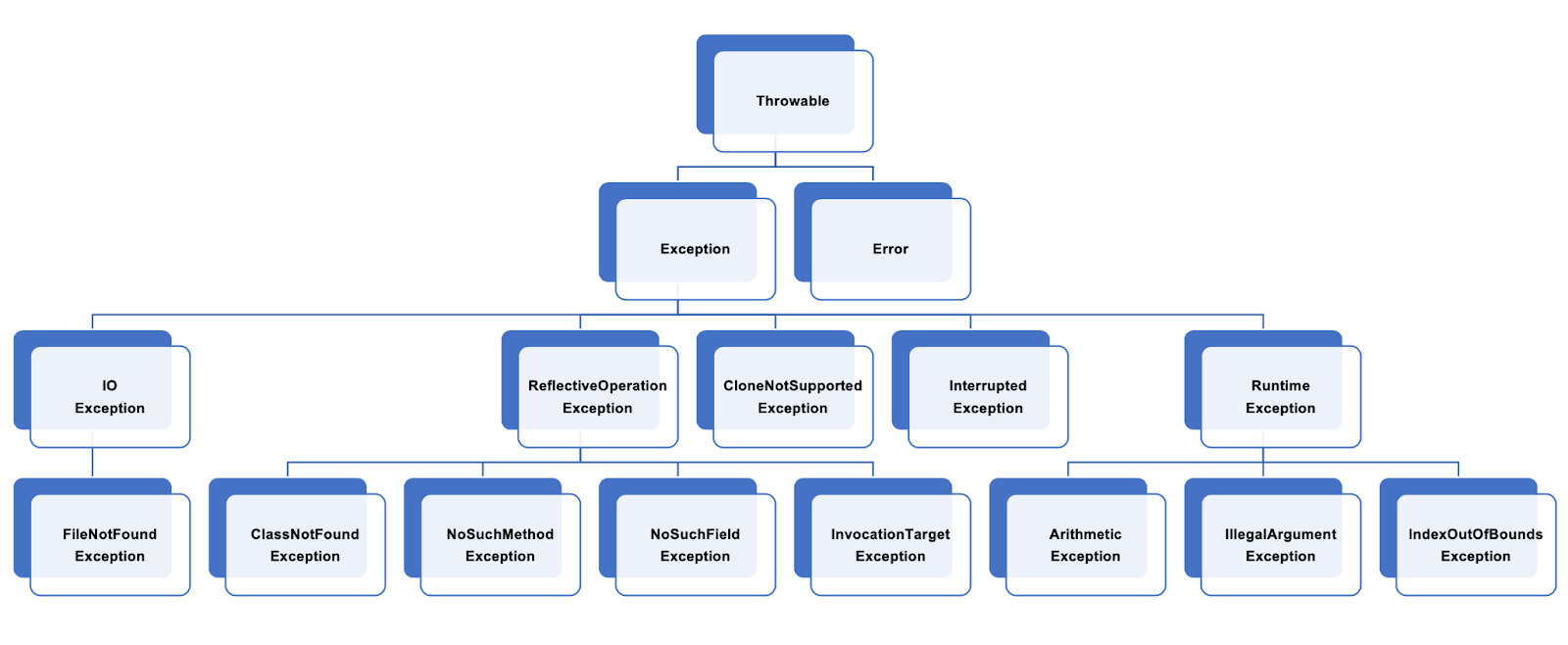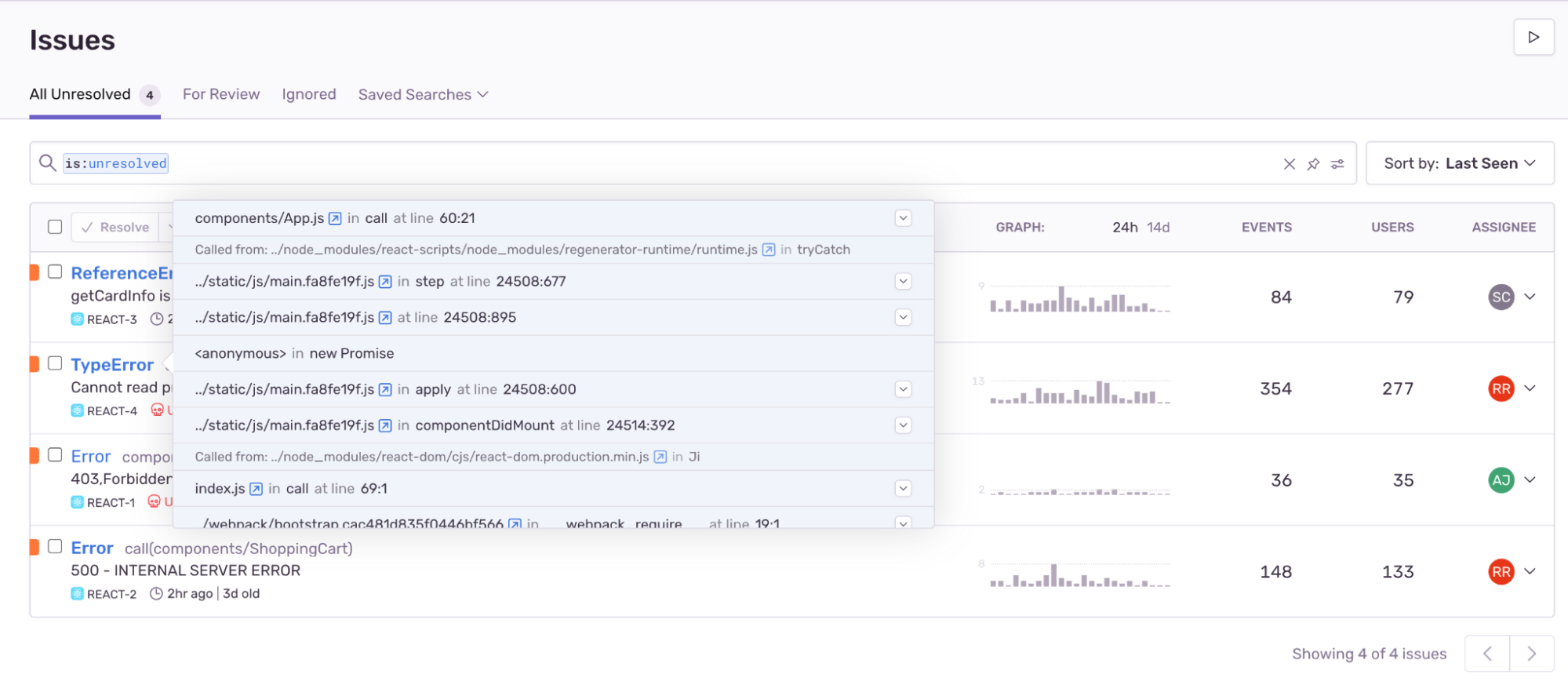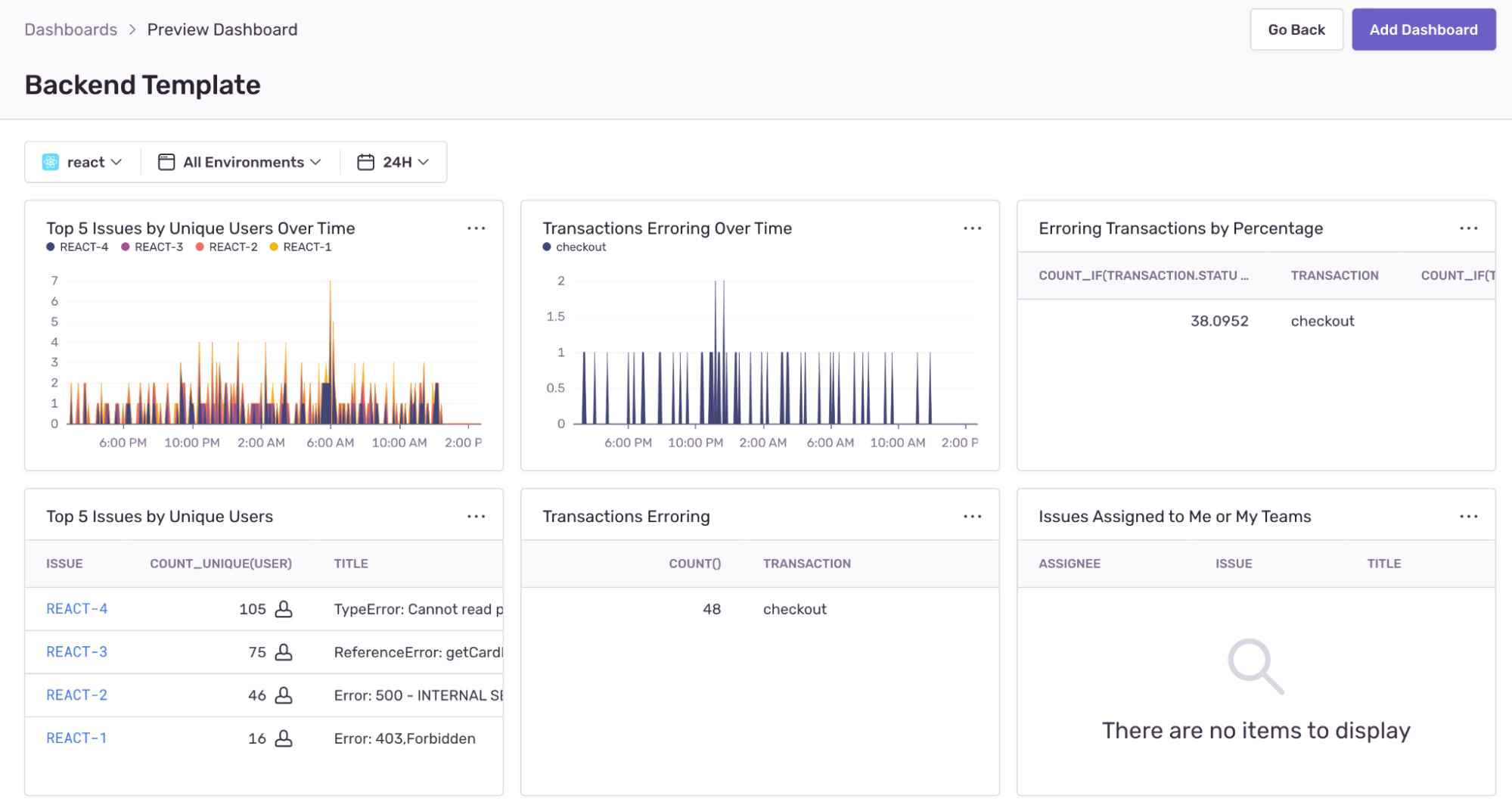Exception Handling in Java (with Real Examples)

ON THIS PAGE
- What are Exceptions in Java?
- What happens when a method throws an exception?
- Why is exception handling important in Java?
- What types of exceptions exist in Java?
- Understanding the Hierarchy of Exception Classes in Java
- Common examples of handling exceptions in Java
- How Sentry can help monitor and resolve exceptions in Java
Java has long been a popular choice among developers globally, making it a natural starting point for many who are beginning their careers in programming. Its widespread use and versatility continue to attract new learners.
Of course, there’s more to learning Java than just knowing the proper syntax and effective code hygiene. Any developer who hopes to use Java for commercial development must be able to quickly and competently identify and recognize errors in their code.
Code editors are great at catching basic programming errors, but more complex issues will sometimes surface during compilation or runtime. One tool that’s great at managing unexpected conditions in runtime is exception handling.
When it comes to improving code, both novice and more experienced programmers could do well to understand how to use exception handling. This article will cover not only the basics of exception handling in Java but also how Sentry can help make exception handling simple and more powerful.
What are Exceptions in Java?
An exception in Java is “an event, which occurs during the execution of a program, that disrupts the normal flow of the program’s instructions.” There are many typical causes for exceptions in Java, including:
Loss of network connectivity
Invalid input data
Requests for missing or non-existent files
Exceeding memory limits for the Java Virtual Machine (JVM)
Code errors
Exceptions are distinct from errors because errors are more serious issues that the application “should not try to catch.” Most developers, however, consider errors to be just a subset of exceptions.
What happens when a method throws an exception?
Errors encountered during runtime create exception objects containing basic information about the exception, including the type of exception generated and the system’s state at the time of the exception. The method then throws the exception to the runtime system for processing.
After receiving an exception, the runtime system tries to find a way to resolve it. Tracing backward through the call stack from the method where the exception occurred, the runtime system looks for an existing method that can process the exception. These methods are called exception handlers. If no method in the call stack can handle the exception, both the runtime system and the application stop.
Why is exception handling important in Java?
Exception handling in Java is crucial for the proper functioning of your applications. With exception handling, developers define the steps for addressing compilation or runtime errors to ensure that there are no interruptions in program flow. As a result, Java applications are more stable and offer better user experiences. And because coding errors that lead to exceptions can be points of vulnerability for cyberattacks, effective exception handling can lead to more secure code.
What types of exceptions exist in Java?
To best understand how to use exceptions and exception handling, it’s important to also be familiar with the types of exceptions built into Java.
Java’s built-in exceptions fall into two broad categories: checked and unchecked exceptions. Checked exceptions are compile-time rather than runtime exceptions. During compilation, the compiler specifically looks for checked exceptions and whether the program includes exception handlers. The compiler generates a compilation error if no appropriate exception handler exists for a checked exception.
In contrast, unchecked exceptions are runtime exceptions, and the compiler will generally ignore them.
More advanced Java programmers can also create custom exceptions to gain even deeper insight into the functioning of their code. Custom exceptions can be tremendously useful for pinpointing issues with specific business logic that the built-in Java exceptions would not catch, helping your business build the best possible reputation for its products.
Understanding the Hierarchy of Exception Classes in Java
Java organizes exceptions within a hierarchy under the Throwable class. At the top level, it separates issues into two main categories: exceptions and errors. The exceptions branch is further classified by specific types. The most prominent subclasses within the exceptions hierarchy include:
IOExceptionReflectiveOperationExceptionCloneNotSupportedExceptionInterruptedExceptionRuntimeException
All RuntimeExceptions are unchecked exceptions, while all remaining exceptions are checked.
Common examples of handling exceptions in Java
While the complete list of built-in exceptions is extensive, some are encountered far more often than others.
Common checked exceptions
Many checked exceptions occur when the program cannot find items it expects to encounter. These exceptions use phrases like NotFound or NoSuch in their name and are part of the ReflectiveOperationException subclass.
ClassNotFoundException
This is one of the most common exceptions in Java. There are several situations where a ClassNotFound exception can occur, including:
Java
ClassLoaderorClass.forName()methods cannot find a specified class in theCLASSPATHwhen attempting to load the class.Attempting to load Java database connectivity (JDBC) files using
Class.forName()if the jar file is not in the class’s path.
It is simple to set up a test of the ClassNotFound exception using a try...catch block. The try...catch block is specifically intended to identify potential exceptions. The try statement encloses potentially problematic code, and the catch defines the exception for which you are testing and performs any actions the developer wants to occur in the event of an exception. Importantly, rather than terminating when the exception occurs, the program continues to run.
public class ExceptionTest {
public static void main(String args[])
{
try {
Class.forName("FindMissingClass");
}
catch (ClassNotFoundException ex) {
ex.printStackTrace();
}
}
}When this code runs, the compiler outputs a ClassNotFound exception:
java.lang.ClassNotFoundException: FindMissingClass
at java.base/jdk.internal.loader.BuiltinClassLoader.loadClass(BuiltinClassLoader.java:641)
at java.base/jdk.internal.loader.ClassLoaders$AppClassLoader.loadClass(ClassLoaders.java:188)
at java.base/java.lang.ClassLoader.loadClass(ClassLoader.java:520)
at java.base/java.lang.Class.forName(Native Method) at java.base/java.lang.Class.forName(Class.java: 375)
at ExceptionTest.main(ExceptionTest.java:8)Another example of this type of reflection exception is the FileNotFoundException, which can occur when a file is absent, or the application does not have sufficient permission to access it.
Resolving the ClassNotFound exception involves reviewing your CLASSPATH to ensure that all necessary classes and jar files are appropriately identified.
NoSuchMethodException
Not surprisingly, Java throws a NoSuchMethod exception when attempting to call a non-existent class method or a private method. A simple example shows how this exception can arise when a developer is not careful about defining and using method names.
class ExceptionTest
{
public void method1(String firstString)
{
System.out.println(firstString)
}
}
public class BadMethodCall
{
public static void main(string[] args)
{
ExceptionTest obj = new ExceptionTest();
obj.method1("This is the first method");
obj.method2("This is the missing method");
}
}Note that we did not use a try...catch block in this example. Unlike ClassNotFoundException, NoSuchMethodException can not be thrown in a try...catch block.
During compilation, you will get a missing method error, although it will show differently than with ClassNotFoundException:
/BadMethodCall.java:15: error: cannot find symbol obj.method2("This is the missing method");
^
symbol: method method2(String)
location: variable obj of type ExceptionTest
1 errorInterrupted Exception
Java throws an InterruptedException if a thread that is either occupied or not currently active (e.g., sleeping or waiting) is interrupted. You can create an interruption to show how this exception works:
class InterruptedThread extends Thread {
public void run() {
try {
Thread.sleep(100);
}
catch (InterruptedException ex) {
ex.printStackTrace();
}
}
}
public class InterruptedExceptionTest {
public static void main(String[] args) {
InterruptedThread sleepingthread = new InterruptedThread();
sleepingthread.start();
sleepingthread.interrupt();
}
}After creating the InterruptedThread class, starting a thread, making it sleep for 100 ms, and then introducing an interrupt, Java throws an InterruptedException:
java.lang. InterruptedException: sleep interrupted
at java.base/java.lang.Thread.sleep(Native Method)
at InterruptedThread.run(InterruptedExceptionTest.java:5)InvocationTargetException
This exception is actually an indicator of an underlying exception in a method. Java throws the exception when an attempt is made to invoke a method that throws the primary exception. InvocationTargetException does not provide specifics on the underlying exception, although developers can use the getCause() method for further information.
Common unchecked exceptions
Recall that unchecked examples only arise at runtime rather than appearing during compilation.
IllegalArgumentException
An IllegalArgumentException is thrown when input to a method is of the wrong type; for example, an array is passed when the method accepts only integer input or if the input is out of a specified input range. You can use the throw exception statement or try...catch blocks to create error messages if a user submits improper input data.
Similar exceptions in Java exist for various other conditions, such as ArrayIndexOutofBoundException or NumberFormatException.
ArithmeticException
As its name implies, Java throws an ArithmeticException if the program attempts an arithmetic operation that is inconsistent with Java operations. The most common example is dividing by zero.
public class ExceptionTest {
public static void main(String[] args) {
try {
int divbyzero = 1/0;
}
catch (ArithmeticException ex) {
ex.printStackTrace();
System.out.println("ERROR: Divide by zero");
}
}
}As you can see, the program not only prints out the stack trace to show the exception but also outputs an error message for the user:
ERROR: Divide by zero
java.lang.ArithmeticException: / by zero
at ExceptionTest.main(ExceptionTest.java:5)These are just a few of the built-in exceptions that developers can use to control application flow, inform users and themselves when there are issues in the code, and build more robust and stable applications. For more on exceptions, see the Java online documentation.
How Sentry can help monitor and resolve exceptions in Java
Your compiler and runtime environments provide basic information on exceptions, but it can be unhelpful. Performance monitoring products like Sentry provide greater visibility into your code and exceptions, making it simple for you to quickly and easily see all unhandled exceptions in a way that allows you to prioritize your correction efforts easily.
Sentry has several features that make it easier for you to understand what your exceptions are, how they are related, and how they tie to other components like APIs. It organizes similar exceptions into issues, minimizing the time needed to review and triage exceptions, and has built-in algorithms for grouping issues which developers can also define using their own grouping criteria.
With its distributed tracing methods, Sentry also monitors application performance and highlights each issue’s impact on users, including how exceptions impact application latency. And using TraceView, Sentry provides more extensive information about each exception.
While knowing what features are available is useful, seeing Sentry in operation brings its issue-handling benefits to life. For a particular issue, Sentry shows you how frequently it is occurring and how many users it impacts, making it easier for you to prioritize your remediation efforts quickly.
You can then hover over an issue to get more specifics about what parts of the code give rise to the exceptions.
And for even greater detail, you can follow the dropdown next to each specific code item to see the code itself.
In addition, with the breadcrumbs feature, developers can visualize a detailed timeline of the events that occurred before a specific error.
As with other Sentry features, you can customize breadcrumbs to meet your own needs and debugging tactics.
Sentry knows that you may have sensitive data that you have to protect at all times (e.g., user credentials). They apply advanced data scrubbing algorithms to redact sensitive information from your data sources. You can also define and implement your own data-scrubbing methods.
Sentry also monitors performance and highlights each issue’s impact on users, including how exceptions impact application latency. Sentry’s Performance Monitoring features give you insight into the success or failure of transactions and how they are impacting your users.
You can drill down through transactions to see the users involved and the individual transaction traces for each individual. And for each trace, you can drill down even further to give you even greater visibility.
Even the most advanced tool will fail if it isn’t simple to use and understand. So Sentry provides a rich set of easily comprehensible, customizable overview dashboards so you can immediately assess the health of your application. With easily added dashboard widgets, you can build a view that focuses on your primary issues of interest.
It is obvious how Sentry simplifies the developer’s task of tracing and resolving issues and exceptions.
These are only a few of the many features that make Sentry a must-have addition to the development toolbox for Java developers serious about exception handling. For more detailed information, check out their documentation or signup to get started.
FAQs
Java exceptions are broadly categorized into checked and unchecked exceptions. Checked exceptions are detected during compilation, while unchecked exceptions occur at runtime. Additionally, developers can create custom exceptions to handle specific business logic.
Checked exceptions include ClassNotFoundException, NoSuchMethodException, and InterruptedException, among others. These exceptions typically arise from issues like missing classes, non-existent methods, or interrupted thread operations. Handling them involves using try-catch blocks to catch and handle the exceptions gracefully.
Unchecked exceptions, such as IllegalArgumentException and ArithmeticException, occur at runtime and are often a result of improper input or arithmetic operations. Unlike checked exceptions, they are not required to be caught explicitly but should be handled appropriately for robust error management.
Sentry streamlines the debugging process by organizing exceptions into issues, providing detailed insights into their occurrence frequency and impact on users. Developers can visualize exception traces, analyze code segments, and scrub sensitive data for enhanced security. Additionally, Sentry offers comprehensive performance monitoring to track application latency and transaction success/failure.
Sentry offers a user-friendly interface with customizable overview dashboards, allowing developers to assess application health at a glance. Its intuitive navigation and drill-down features enable detailed analysis of exception traces, transactions, and performance metrics, empowering developers to resolve issues efficiently.
Sentry employs advanced data scrubbing algorithms to redact sensitive information from exception traces and performance metrics, ensuring data privacy and compliance with security standards. Developers can also define and implement custom data scrubbing methods to safeguard sensitive data effectively.
Developers can access Sentry’s documentation and signup to start leveraging its features for exception monitoring and debugging in Java applications. Sentry offers comprehensive guides and resources to help developers integrate and configure the platform effectively.












